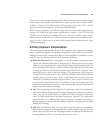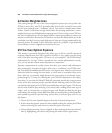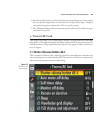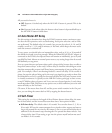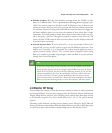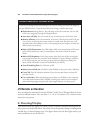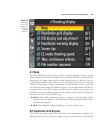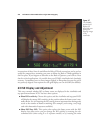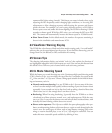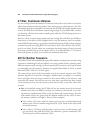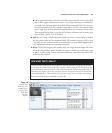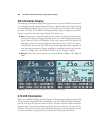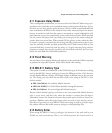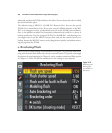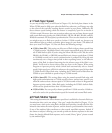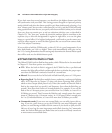command dial (when using A mode). This feature can come in handy when you’re
adjusting the ISO frequently under changing light conditions, or are using ISO
adjustments to allow changing exposure while keeping the aperture and shutter
speeds the same. For example, say you’re using Aperture-priority at ISO 200 to
shoot a sports event and, under the current lighting, the D7000 is choosing 1/250th
second as a shutter speed. With Easy ISO active, you can bump the ISO up to ISO
400. The camera will automatically increase the shutter speed to 1/500th second.
■ Show Frame Count. In this default mode, the number of exposures remaining is
shown in the viewfinder and monochrome LCD.
d4 Viewfinder Warning Display
The D7000 has a low-battery, black-and-white mode warning, and a “no card loaded”
advisory that can be superimposed on the screen. If you find this distracting, you can
change from On (the default) to Off, and disable the warning.
d5 Screen Tips
The shooting information display can include “tool tips” that explain the function of
any highlighted adjustable item in the bottom two rows. You can turn this feature from
the default On to Off once you’ve learned which task each entry performs.
d6 CL Mode Shooting Speed
While the frames per second shooting rate at the Continuous high speed shooting mode
(C
H
) is fixed at 6 fps, you can adjust the speed for the Continuous low speed mode
(C
L
). You can select 1 to 5 fps rates. Choose a firing speed suitable for the kind of shoot-
ing environment you’re in:
■ Normal continuous shooting. I set my D7000 to the 1 fps rate most of the time,
so that I can take multiple shots quickly without needing to press the shutter release
repeatedly. A one-second rate isn’t so fast that I end up taking a bunch of shots that
I don’t want, but it is fast enough that I can shoot a series.
■ Bracketing. When I’m using bracketing, I generally have the D7000 set to shoot
a bracketed set of three pictures: normal, over-, and underexposure. With the cam-
era set to 3 fps, I can press the shutter once and take all three bracketed shots, with
basically the same framing, within about one second.
■ Slower action sequences. The 6 fps rate available for sports photography often pro-
duces an embarrassing plethora of pictures that are a pain to wade through after the
event is over. For some types of action, such as long distance running, golf, swim-
ming, or routine baseball plays, a rate of 3 to 5 fps might be sufficient. You can
make this more reasonable speed available by defining it here.
Chapter 9 ■ Setup: The Custom Settings Menu 295



